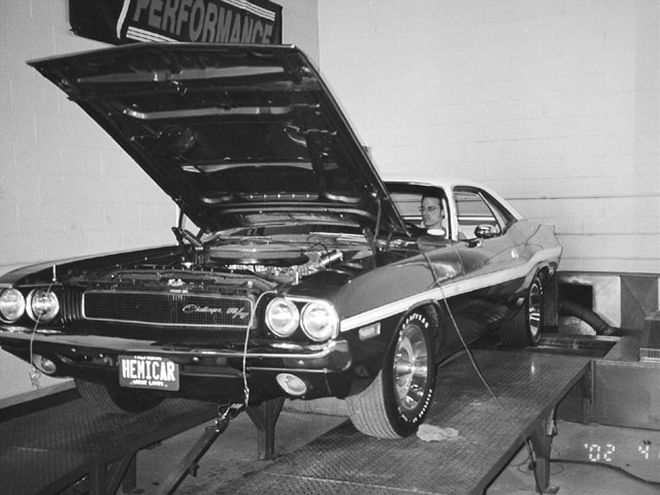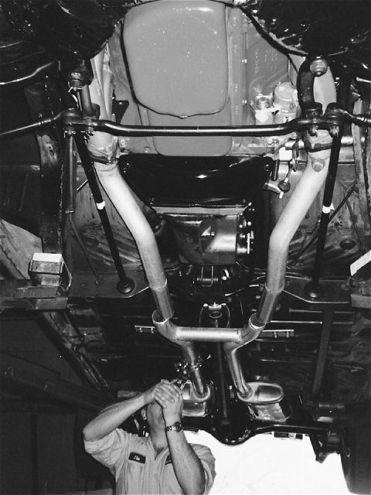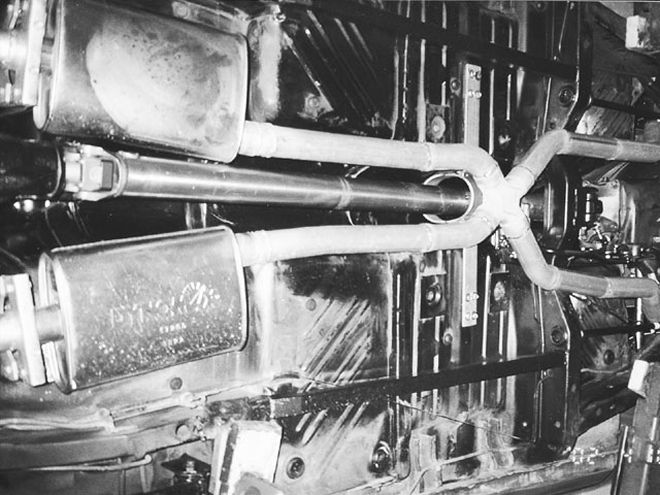
 Strapped to the dyno at Automotive Performance Engineering in Clinton Township, Michigan, our Challenger produced 454 hp with an H-pipe. Will the Dr. Gas X-pipe be an improvement?
Strapped to the dyno at Automotive Performance Engineering in Clinton Township, Michigan, our Challenger produced 454 hp with an H-pipe. Will the Dr. Gas X-pipe be an improvement?
Accepting change is never easy, especially when you have to leave something behind that you know works. If you had looked under a performance car a few year ago, chances are you'd find an H-pipe in the exhaust system. The purpose of this pipe, which links the two intermediate sections of a dual exhaust, is to trick the exhaust into thinking it's bigger than it really is. By connecting the two exhaust pipes in this manner, backpressure is effectively reduced because it sends excess pressure from one pipe to the other at a time when there is no exhaust pulse on the second side. This process is only effective at low- to mid-range rpm and has no effect at higher rpm.
Relatively new technology has told us there is something better. Enter the X-pipe. Because of the basic design of the X, it reduces noise and synchronizes the exhaust pulse of both engine-cylinder banks. The X-pipe is not restricted by exhaust pulses because the nature of an X in the exhaust system allows both pipes to join at a single location. An H-pipe, on the other hand, has to pass through yet another piece of pipe added to the system. With the X-pipe, throttle response is improved and the exhaust flow is completely smoothed out. The deep, throaty growl of a performance dual exhaust is replaced with slightly higher pitch and smoother sound. Tests have shown up to a 75-percent reduction in decibel levels
 With the base numbers in, we took the Challenger to Car Pro in Mount Clemens, Michigan, to have the X-pipe installed. Here you can see the H being removed.
With the base numbers in, we took the Challenger to Car Pro in Mount Clemens, Michigan, to have the X-pipe installed. Here you can see the H being removed.
There are several manufacturers of X-pipes. For our tests we turned to Dr. Gas of Sandy, Utah, and parlayed a 21/2-inch Synchronizing Crossover Kit to prove our point. But the test is useless without a stout-performing car to try it out.
Dave Dudek of Shelby Township, Michigan, is the current reigning Factory Stock Appearing race champion. His '70 Challenger (featured April '02) runs high-11-second quarter-mile times. This may not seem that impressive, but he does the quarter-mile on repop Polyglas tires, exhaust manifolds, a "stock-sounding" camshaft, and a four-speed tranny. OK, so it's a Hemi, but still . . .
To start the test, we first strapped the Challenger to the dyno to get a baseline with the H-pipe-fitted exhaust. Peak horsepower of 454 was achieved at 5,400 rpm, and peak torque was 472 lb-ft at 4,500 rpm.
Dyno Horsepower ResultsHorsepowerRPMH-PipeX-Pipe3,000244249+53,{{{100}}}254264+83,{{{200}}}269283+143,{{{300}}}282303+213,400292313+213,500300324+243,{{{600}}}308332+243,700315337+223,800330347+173,{{{900}}}338350+124,000350361+114,100358372+144,200373386+134,300384395+114,400393408+154,500404415+114,600413425+124,700422434+124,800431442+114,900434446+125,000439453+145,100443459+165,200449460+115,300454463+95,400453466+135,500454464+105,600450459+95,700445451+65,800438444+65,900429430+16,000425427+2Average horsepower from 3,000 to 6,000 rpm H-pipe 379.8; X-pipe 392.3
An increase of 12.5 hp with the X-pipe
 The X-pipe is unnoticeable from outside the car unless you lie on the ground and look for it.
Dyno Torque ResultsTorqueRPMH-PipeX-Pipe3,000426442+163,{{{100}}}435450+153,{{{200}}}442456+143,{{{300}}}449461+123,400449461+123,500450462+123,{{{600}}}449462+133,700449466+173,800455470+153,{{{900}}}457473+164,000460472+124,100460476+164,200467483+164,300467483+164,400469487+184,500472485+134,600472484+124,700470486+164,800472483+114,900466478+125,000461476+155,100456473+175,200454464+105,300450460+105,400441455+145,500435443+85,600422431+95,700409415+65,800395402+75,900381383+26,000374374+0
The X-pipe is unnoticeable from outside the car unless you lie on the ground and look for it.
Dyno Torque ResultsTorqueRPMH-PipeX-Pipe3,000426442+163,{{{100}}}435450+153,{{{200}}}442456+143,{{{300}}}449461+123,400449461+123,500450462+123,{{{600}}}449462+133,700449466+173,800455470+153,{{{900}}}457473+164,000460472+124,100460476+164,200467483+164,300467483+164,400469487+184,500472485+134,600472484+124,700470486+164,800472483+114,900466478+125,000461476+155,100456473+175,200454464+105,300450460+105,400441455+145,500435443+85,600422431+95,700409415+65,800395402+75,900381383+26,000374374+0
Average torque from 3,000 to 6,000 rpm H-pipe 445.6; X-pipe 457.9
An increase of 12.3 over H-pipe
With the X-pipe installed on the Hemi Challenger, it was time to see if it was worth the work. The sound was definitely quieter, but is the quieter exhaust tone a hint of a reduction in horsepower? Let's hope not.
Back at the dyno, Rich Gala dropped the hammer on the big Hemi. Sure enough, the X-pipe produced an improvement in horsepower and torque with a quieter exhaust tone. The peak horsepower with the X-pipe was 466 at 5,400 rpm, while the torque rose to 487 at 4,400 rpm. That's an increase of 12 hp and 15 lb-ft of torque over the H-pipe. We call that substantial. The horsepower and torque reached peak a lot quicker than with the H-pipe, and maintained it throughout the rpm range-definitely worth the afternoon we spent under the Challenger to install the Dr. Gas unit.